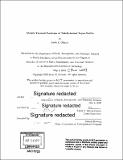| dc.contributor.advisor | Linda T. Elkins-Tanton. | en_US |
| dc.contributor.author | Gelman, Sarah E. (Sarah Eva) | en_US |
| dc.contributor.other | Massachusetts Institute of Technology. Department of Earth, Atmospheric, and Planetary Sciences. | en_US |
| dc.date.accessioned | 2018-03-27T14:19:34Z | |
| dc.date.available | 2018-03-27T14:19:34Z | |
| dc.date.copyright | 2009 | en_US |
| dc.date.issued | 2009 | en_US |
| dc.identifier.uri | http://hdl.handle.net/1721.1/114370 | |
| dc.description | Thesis: S.B., Massachusetts Institute of Technology, Department of Earth, Atmospheric, and Planetary Sciences, 2009. | en_US |
| dc.description | Cataloged from PDF version of thesis. | en_US |
| dc.description | Includes bibliographical references (pages 37-41). | en_US |
| dc.description.abstract | Most super-Earth (mass < 10M[mathematical symbol]) detection techniques are biased towards massive planets with close-in orbits. A planet's orbital decay timescale decreases with a lower semi-major axis, thereby providing a high probability of detecting exoplanets which are in tidal-lock with their star. We model the effect of fixed stellar flux on an Earth-like planet's mantle convection structure and evolution using an axisymmetric finite element fluid convection code, SSAXC. Three punctuating evolutionary steps have been identified. First, a sequence of three initial downwellings form at the antistellar point, the substellar point, and at the terminator. After approximately 250,000 years, lithospheric instabilities drip down into the mantle, inducing pervasive small scale convective cells. Finally, after 3.5 billion years of planetary evolution, a cold region (~ 300°C) develops at the antistellar point, spanning the depth of the mantle, and inducing a pseudo-Mode 1 convective pattern. Though initial models have focused on an incoming stellar flux equivalent to that at the Earth, we also discuss the possibility of steady-state partial magma oceans in the substellar region induced by higher stellar fluxes. We propose that, though these tidally-locked planets may not be considered habitable in general, they may contain locally habitable regions due to their variety of long-lived extreme environments. | en_US |
| dc.description.statementofresponsibility | by Sarah E. Gelman. | en_US |
| dc.format.extent | 52 pages | en_US |
| dc.language.iso | eng | en_US |
| dc.publisher | Massachusetts Institute of Technology | en_US |
| dc.rights | MIT theses are protected by copyright. They may be viewed, downloaded, or printed from this source but further reproduction or distribution in any format is prohibited without written permission. | en_US |
| dc.rights.uri | http://dspace.mit.edu/handle/1721.1/7582 | en_US |
| dc.subject | Earth, Atmospheric, and Planetary Sciences. | en_US |
| dc.title | Mantle thermal evolution of tidally-locked super-earths | en_US |
| dc.type | Thesis | en_US |
| dc.description.degree | S.B. | en_US |
| dc.contributor.department | Massachusetts Institute of Technology. Department of Earth, Atmospheric, and Planetary Sciences | |
| dc.identifier.oclc | 1028992553 | en_US |
